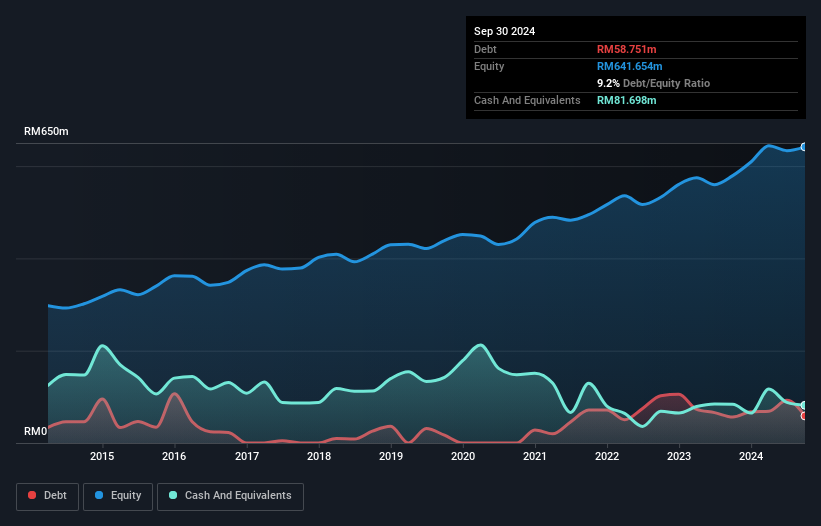
Howard Marks put it nicely when he said that, rather than worrying about share price volatility, 'The possibility of permanent loss is the risk I worry about... and every practical investor I know worries about.' So it seems the smart money knows that debt - which is usually involved in bankruptcies - is a very important factor, when you assess how risky a company is. As with many other companies P.I.E. Industrial Berhad (KLSE:PIE) makes use of debt. But the real question is whether this debt is making the company risky.
What Risk Does Debt Bring?
Generally speaking, debt only becomes a real problem when a company can't easily pay it off, either by raising capital or with its own cash flow. Ultimately, if the company can't fulfill its legal obligations to repay debt, shareholders could walk away with nothing. While that is not too common, we often do see indebted companies permanently diluting shareholders because lenders force them to raise capital at a distressed price. Of course, plenty of companies use debt to fund growth, without any negative consequences. The first step when considering a company's debt levels is to consider its cash and debt together.
See our latest analysis for P.I.E. Industrial Berhad
What Is P.I.E. Industrial Berhad's Debt?
You can click the graphic below for the historical numbers, but it shows that as of September 2024 P.I.E. Industrial Berhad had RM58.8m of debt, an increase on RM56.2m, over one year. However, it does have RM81.7m in cash offsetting this, leading to net cash of RM22.9m.

How Strong Is P.I.E. Industrial Berhad's Balance Sheet?
According to the last reported balance sheet, P.I.E. Industrial Berhad had liabilities of RM193.7m due within 12 months, and liabilities of RM11.1m due beyond 12 months. Offsetting these obligations, it had cash of RM81.7m as well as receivables valued at RM261.3m due within 12 months. So it can boast RM138.2m more liquid assets than total liabilities.
This short term liquidity is a sign that P.I.E. Industrial Berhad could probably pay off its debt with ease, as its balance sheet is far from stretched. Simply put, the fact that P.I.E. Industrial Berhad has more cash than debt is arguably a good indication that it can manage its debt safely.
But the bad news is that P.I.E. Industrial Berhad has seen its EBIT plunge 13% in the last twelve months. If that rate of decline in earnings continues, the company could find itself in a tight spot. When analysing debt levels, the balance sheet is the obvious place to start. But it is future earnings, more than anything, that will determine P.I.E. Industrial Berhad's ability to maintain a healthy balance sheet going forward. So if you want to see what the professionals think, you might find this free report on analyst profit forecasts to be interesting.
But our final consideration is also important, because a company cannot pay debt with paper profits; it needs cold hard cash. P.I.E. Industrial Berhad may have net cash on the balance sheet, but it is still interesting to look at how well the business converts its earnings before interest and tax (EBIT) to free cash flow, because that will influence both its need for, and its capacity to manage debt. Over the last three years, P.I.E. Industrial Berhad reported free cash flow worth 7.5% of its EBIT, which is really quite low. For us, cash conversion that low sparks a little paranoia about is ability to extinguish debt.
Summing Up
While it is always sensible to investigate a company's debt, in this case P.I.E. Industrial Berhad has RM22.9m in net cash and a decent-looking balance sheet. So we are not troubled with P.I.E. Industrial Berhad's debt use. Over time, share prices tend to follow earnings per share, so if you're interested in P.I.E. Industrial Berhad, you may well want to click here to check an interactive graph of its earnings per share history.
Of course, if you're the type of investor who prefers buying stocks without the burden of debt, then don't hesitate to discover our exclusive list of net cash growth stocks, today.
New: Manage All Your Stock Portfolios in One Place
We've created the ultimate portfolio companion for stock investors, and it's free.
• Connect an unlimited number of Portfolios and see your total in one currency
• Be alerted to new Warning Signs or Risks via email or mobile
• Track the Fair Value of your stocks
Have feedback on this article? Concerned about the content? Get in touch with us directly. Alternatively, email editorial-team (at) simplywallst.com.
This article by Simply Wall St is general in nature. We provide commentary based on historical data and analyst forecasts only using an unbiased methodology and our articles are not intended to be financial advice. It does not constitute a recommendation to buy or sell any stock, and does not take account of your objectives, or your financial situation. We aim to bring you long-term focused analysis driven by fundamental data. Note that our analysis may not factor in the latest price-sensitive company announcements or qualitative material. Simply Wall St has no position in any stocks mentioned.
About KLSE:PIE
P.I.E. Industrial Berhad
An investment holding company, manufactures and sells industrial products in Malaysia, other Asia Pacific countries, the United States, Europe, and Africa.
High growth potential with excellent balance sheet.
Similar Companies
Market Insights
Community Narratives


